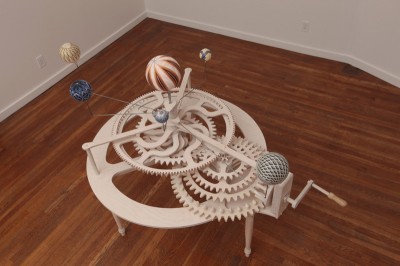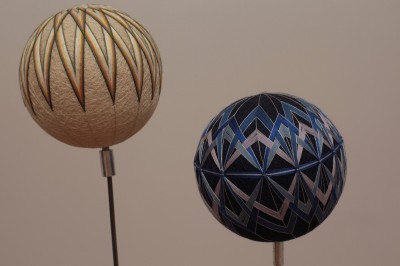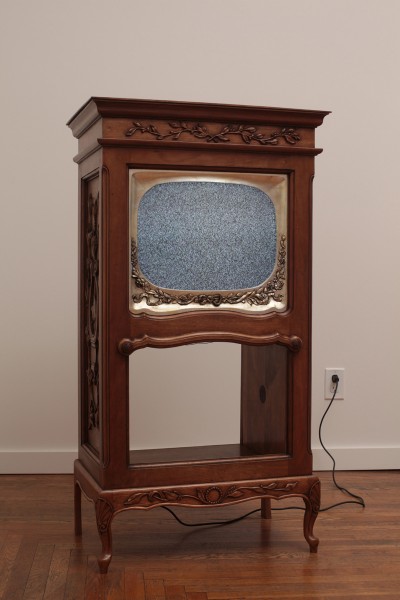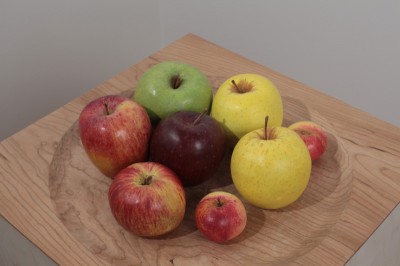Finely Crafted Memories:
The Work of Kazumi Tanaka
Daniel Levis Keltner

Refreshingly intimate yet complex, the work of Kazumi Tanaka invites viewers on an imaginative journey into the distinctive world of the artist. This trip is characterized by the wonder and strangeness of childhood, rendered by the skill and acumen of adulthood.
In the realm of strangeness, Tanaka’s “Claustrophobia” challenges a viewer’s relationship to objects in physical space. In this piece, a corner of stacked dressers is presented of dollhouse proportions. The size allows us to see the entire space at once and so recognize it not as a series of distinct objects but altogether as a scene. The placing of furniture largest- (outside) to-smallest (inside) serves to funnel our line of sight so that, as we orient the furniture in relation to size and space, our perspective gets reoriented to the scene as well. Consequently, “Claustrophobia” makes us feel smaller and smaller in relation, until almost smothered by the now heavy wooden furniture. The grace of this piece resides in the nearly secret spot at the far rear—a hideaway stocked with another, toy-sized chest of drawers, a place where a child (we?) might take shelter.
On her website, Tanaka provides narratives to accompany certain pieces, which serve as keys, not to unlock the power of the work, but to reveal its personal significance to the artist. The narrative for this piece reads:
When my mother married my father, her parents bought her lots of furniture hoping to make her feel comfortable in her new surroundings.
So, she brought them to her new home and created her tiny corner, which was the only comfort space for her. My brother and I used to play hide and seek in this corner.
I imagined sleeping in this tight space as if I were sleeping inside of my mother.
Being the youngest child of my mother who was also the youngest of six, I fantasized about being the tiniest Russian doll.
Though this memory is not ours, Tanaka does not alienate her audience by delving into personal narrative. Instead, her candor welcomes us by taking the audience into her confidence. In a recent interview with Newfound, Tanaka said that, “By taking the story telling process, I am hoping to communicate with people without being didactic.” Tanaka’s “Claustrophobia” accomplishes that goal, drawing in the viewer until that they too to partake in this fantastic transformation of becoming a tiny Russian doll.

This manner of confessional play is enacted in much of her work. “Recording,” originally a part of the Masters & Pelavin Gallery show “Silence,” is another great example.
The piece is composed of a record player that silently spins a record made of wood, shellac, and Tanaka’s own hair. The accompanying story reads:
My 50th birthday is coming soon.
I am spinning and turning while I am still in my 40’s.
Maybe I’m thinking…in silence.
I’m thinking…of my new movement.
I’m thinking…right now.
Through the power of imagination, what we see (the record) now appears like magic before us: Tanaka herself spinning, reflecting on her life. As the independent curator and art historian France Morin said of Tanaka’s work, “…[she] entices us into a magical world, like that of Alice in Wonderland, which the artist also enters and leaves-sometimes to escape the anxieties of the world.” But this piece’s magic doesn’t lie all in physical transformation. Like much of her work, the piece serves as a metaphor that opens a gate to psychological transformation, inviting a viewer to reflect on her or his own life and mind, also turning in time.
One of Tanaka’s larger showpieces is “Orrery,” a mechanical device that illustrates the relative positions and motions of planets in our Solar System, originating from Greek planetaria. “Orrery” is made of hand-carved wooden gears with handmade temari balls for planets (temari balls are traditionally given in Japan as gifts of deep friendship and loyalty). The creation of each item, both the orrery and temari, demonstrates the artist’s high degree of technical skill in old Western and Eastern crafts. Once again, motion brings magic and meaning to the work, showing us a world relying symbolically on both cultures to set a good world whirling.


Tanaka’s work is so well crafted that her pieces often have the bearing of found objects, artifacts. All her wooden structures are built from raw materials, cut and fashioned into art, as she is a carpenter, finisher, and painter. Tanaka notes, “People always wonder how I made them or simply don’t think I made them.” The mass manufacturing of cheap goods is perhaps partly responsible, as many of the skills necessary to construct such work from scratch are beyond most of us.


Her “Insomnia” alone took three years to complete. To build the cabinet/TV combo, Tanaka took apart the electronic components of her old TV and installed it in the cabinet she built. The finished piece appears portentous, dreamlike. The steady waves of the static across the screen, coupled with the sound of birdcall (an MP3 loop), lend a surreal character to the finely made cabinet. While the finish and detail invites us to draw nearer for closer inspection, the pleasant birdcall and dead gray screen functions like a Greek Siren, entrancing us before the object. As motion serves to activate her other pieces, “Insomnia” is perhaps doubly striking, engaging a viewer with motion and sound both.

Tanaka one-ups her woodworking ability in the piece “Bad Apple.” Here she reproduces organic objects—seven ripe apples—using plaster, paint, and wood. These apples are nearly indistinguishable from the single real apple in the bunch. Lacking movement or sound, she activates the piece through the element of time—the real apple rots while on display, as the handmade apples remain shiny and fresh. “Bad Apple” is the closest the artist comes to fooling her audience, not communicating in a direct manner. The good-spiritedness remains, however, in enacting Picasso’s wisdom that “Art is a lie that tells the truth.” As Tanaka explains, the piece serves as metaphor for her understanding of good and evil:
I often wonder about the distinction between right and wrong or good and evil. These concepts seem to exist often on the stories but we realize the actual world is more complex and not so black and white. I believe true and untrue exist. The creative process helps me to focus on the complexities of how one can relate to others, raising questions to how I can be true to myself and to others.
The work of Kazumi Tanaka is a form of autobiography, like relics fully charged with the character of their creator. However, the work doesn’t alienate viewers by over-emphasizing personality and asserting ego. Instead, each piece seems intent on communicating visions originating in truth, arising from her unique point of view. Ultimately, the earnestness of Tanaka’s art builds the bridge between the work and the viewer, who is respectfully invited to share in these intimate moments. Of course, the work is not just experiential but offers us important lessons through simple play, which aids to curb didacticism.
In speaking with Newfound about her artistic process, Tanaka related the following story:
I saw a movie a long time ago, (I can’t remember what it was about) but the guy came out of jail after finishing his time there, struggling to make living. He started working in the lampshade factory. He came home tired and told his girlfriend that he realized how, in making one lampshade, there are so many people’s handiwork involved…
I cannot predict if the subject or object comes first or thoughts comes first but in the creative process, it will filter through time, distance, and my own memories, which turns into my work.
A lampshade is a lampshade until you start thinking about the different aspects of it.
As the story illustrates, to make anything well requires collective knowledge, skills handed down from our respective cultural backgrounds, the object further shaped by individual memories and the physical ability of the creator, and the same cultural and personal knowledge needed in a viewer to make any work relevant. Kazumi Tanaka’s art is a testament to the truly great things that can come out of partaking in this process with humility and sincerity.

Daniel Levis Keltner, Managing Editor

Beautifully expressed appreciation of an artist I deeply admire. Thank you.
I had the privilege of seeing some of these pieces in progress in Tanaka’s studio. As a literature and writing teacher, I often tell my students that we can’t ask dead authors what they meant in their works and therefore must interpret and analyze for ourselves. It was a rare and appreciated experience to have an artist’s complex inspiration and process explained in person by the artist herself. This article so well captures and shares Tanaka’s intentions and spirit. Beautiful writing about a beautiful person and her amazing work.
Wonderful, intriguing work.
Kazumi’s work is incredible, as always. I wish a very special person would “discover” her and she would become rich and famous!!!
Kazumi’s work is extraordinary – this article does justice to her art, go and see it when ever you have a chance, it will delight you!